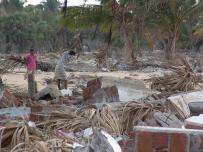Producer Marijke van der Meer was holidaying in Sri Lanka when disaster struck in December 2004. Her personal report from one of the country’s devastated towns told of the harrowing situation there and the desperate need for aid.
Award winning (Re-) Broadcast on 1st March, 2010 How to order allopurinol online
In the southeastern Sri Lankan coastal town of Pottovil – a town with an ethnic mix of Singhalese and Tamils, Muslims and Buddhists – a golden statue of Buddha stares serenely over Arugam Bay. The bay was a Mecca for surfers, who stayed in guesthouses with names such as Chill Space Surf, Hideaway, Aloha and even the Tsunami Beach Hotel. The statue of Buddha is one of the few fully intact constructions in this demolished town where a thick layer of muddy dirt covers the ground.
Destruction and death
Soldiers look on as bulldozers shove aside trees and bricks from destroyed dwellings. The bodies of some 1,000 people – killed within a few seconds of the tsunami – have been recovered. But there are many others missing and many families who have no roofs over their heads and are in so-called ‘collection centres’.
The medical situation is critical in this isolated district, where several people are saying that they feel neglected by the authorities because relief efforts are reaching them only sporadically. I spent today, the last day of 2004, in this town with an American doctor from the United States and a Dutch nurse, tending to patients in a makeshift clinic set up in a boys’ school. I also spoke with the district medical officer in the town, Dr Sadeen.
Disease rears its head
Dr Sadeen says the homeless families have been brought to collection centres, but there are no toilets or clean water and there’s a great danger of contagious diseases spreading. Cases of typhoid fever and diarrhoea have already been recorded, coming on top of the injuries caused in the disaster. There are also cases of unidentified fever and respiratory infections.
There is not enough assistance. The area for which the doctor is responsible once had a population of some 40,000. Everyone is affected. One of the worst affected groups is the fishermen. But farmers are also affected because there is no transport. The harvest has to be brought in soon. People are worried about how they can even find money; only civil servants are still earning a salary.
There are some medical supplies, but medical stores have also been demolished. There is a lot of individual, private help. However, there is still a huge need for antibiotics, painkillers, anti-disease creams and operating equipment including gloves, scalpels, scissor and surgical blades.
They have found 1,000 bodies in the town, however many areas have not been reached yet. Many people are still missing; most of those killed were children. The bodies of westerners have also been found, although the surfing season here was at an end. Bodies which cannot be identified are being photographed and tagged, and the graves are being marked. Some westerners who were injured were taken to hospitals in the region, the most severely stricken part of Sri Lanka.
Long-term care
In the short term, there is a need for tents and toilets. In the longer term, the need will be for housing and transport. As for the mood of the people: this is best explained by the fact that each family in Pottovil has lost at least one person. They are frightened, they want to leave, and they are not eating or sleeping properly. This may indicate what kind of care will be required for them in the long term.
I was given a statement by a local volunteer from Candy who has been working in this remote area since the disaster happened. This is roughly what he told me:
“I was here right after the incidents. The eastern provinces are the most devastated areas; there is great loss of life. I saw one mass burial ground where about 6,000 people have been buried, in Ampara district. It is the biggest graveyard at this moment in Sri Lanka. I personally, together with two friends, have buried 75 bodies. There is no official relief work here yet. The government is neglecting this province. Most aid is going to the south, to Galle and Tangalle. We don’t know why this is happening.”
Adrift in Sri Lanka was originally broadcast in January 2005. The program was produced and presented by Marijke van der Meer and was honoured by the Asia-Pacific Broadcasting Union as Best External Broadcast.
Generico do betnovate http://www.rnw.nl/english/radioshow/adrift-sri-lanka

 Arugam Forum
Arugam Forum Arugam Photo Galleries on Picasa
Arugam Photo Galleries on Picasa Old Website
Old Website Press Coverage
Press Coverage Surf Forecast for Arugam Bay
Surf Forecast for Arugam Bay
0 Responses to “Classic Dox – Adrift in Sri Lanka On air: 5 February 2010 13:20 – 1 March 2010 13:20”